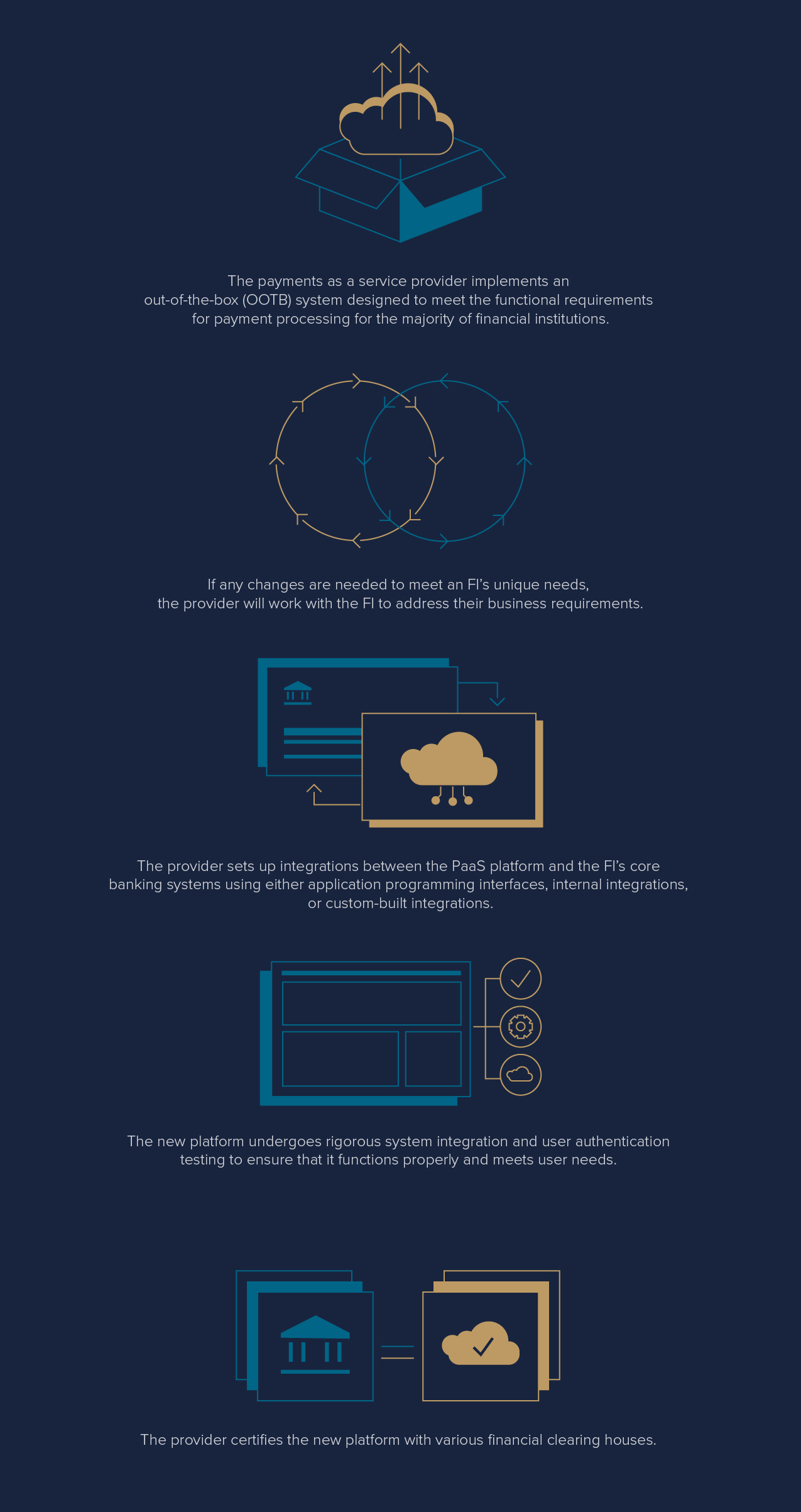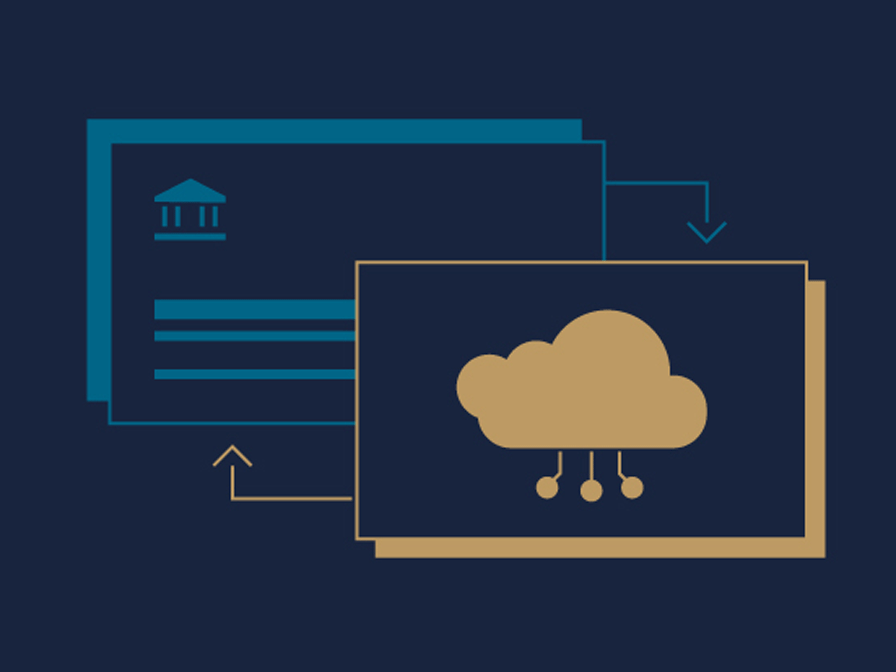
Payments as a service — often abbreviated as PaaS — is a rapidly growing trend in the financial services industry, one that’s transforming the way institutions build, develop, and deploy new payment products and services. In this blog post, we’ll take an in-depth look at what payments as a service is, and how it’s transforming the way financial institutions deploy new payment products and services while decreasing technical dependencies and costs.
What Is Payments as a Service?
Payments as a service is a cloud-based delivery model that enables banks and other financial institutions to process and manage payments using third-party platforms and specialized payment services.
The financial services sector has been notoriously slow to adopt new technology, primarily due to the fact that most financial institutions run their payment infrastructure on legacy systems and have complex software ecosystems to maintain, which can be difficult when integrating new systems or new payment schemes.
Payments as a service helps solve this problem by providing payment services — such as payment processing, transaction reporting, business intelligence, digital channel, and clearing connectivity — to financial institutions over the internet on a subscription basis, eliminating the need for them to install and maintain solutions on their own systems. PaaS providers are responsible for every aspect of both software and infrastructure management, including disaster recovery, data security, regulatory compliance, governance, and ongoing maintenance.
By outsourcing payment services through payments as a service, financial institutions can eliminate much of the complexity associated with integrating new systems with their core banking systems and focus on delivering exceptional service and modern payment capabilities to their customers.
How Does Payments as a Service Work?
PaaS works in much the same way as any other “as a service” model. Payments as a service providers host applications and data on their own servers, databases, and cloud using their own technology stack and networking and computing resources. They then make those applications and data available to financial institutions over the internet through a cloud-based delivery model.
Though actual services will vary by vendor, most payments as a service providers can support software integration, payment processing, reconciliation, settlement, disaster recovery, data security, compliance, reporting, and issue resolution.
The exact process for setting up a payments as a service platform also varies from one vendor to another, but the general process is as follows:

This process can take anywhere from a few months to a full year to complete depending on the complexity of a bank’s existing infrastructure; the number of systems, integrations and interfaces a financial institution requires; the geographies and regions in which a bank operates; and the payments as a service provider’s ability to address its customers’ varying needs.
Understanding the Rise of PaaS
Although payments as a service has existed in some form for over a decade, it’s received renewed attention in recent years due to a number of major changes within the financial services industry.
Rapid payments modernization and recent advancements in consumer technology have led banks to reconsider how they adapt to industry disruptors such as:
- Non-banks, such as tech companies, retailers, fintechs, and telecommunication companies, providing traditional banking services
- Increased eCommerce sales and demand for electronic payments during and in the aftermath of the COVID-19 pandemic
- Growing demand for alternative and emerging payment methods such as FedNow and SEPA instant payments and cross-border payments
- The need to maintain relevance by meeting rising customer expectations, delivering exceptional service, and bringing new products to market quickly, all while controlling operating costs and minimizing overhead
- A rapidly evolving regulatory landscape with complex compliance requirements
- The adoption of open banking initiatives in various markets
- Increasingly sophisticated cybersecurity threats and the need to more effectively manage risk and increase resilience
How Payments as a Service Solves the Key Challenges of Today
The financial services industry stands at a crossroads. In the face of rising customer demand, rapid technology innovation, and increased competition, banks and other FIs must prioritize payments modernization to not just survive, but thrive.
One of the leading challenges for banks today is that they continue to rely on legacy payment systems, which can be costly to manage and maintain, highly complex, and difficult to integrate. According to a survey of FIs and payments ecosystem participants conducted in partnership with Finextra, 47% of respondents said that their primary business case for modernizing payments was to reduce maintenance costs and complexity.
But replacing legacy payment systems with modernized systems can take significant time and resources, and many banks lack the resources necessary to successfully transition. And, should any issues arise during the modernization process, banks and FIs risk service disruption, which can jeopardize business.
Payments as a service solves this challenge by outsourcing every aspect of implementation, integration, management, and maintenance to third-party providers, making it fast and cost-effective for FIs to modernize payment systems. Rather than staff up their own IT teams, banks can instead rely on PaaS providers’ deep bench of highly qualified and experienced IT professionals. This also enables FIs to reallocate their existing IT resources to developing new products and services and driving innovation.
Building integrations becomes simple, as many payments as a service platforms offer OOTB integrations with core banking systems and providers can custom-configure integrations as needed. Depending on the provider, these integrations may even be ISO-certified, dramatically reducing risk. Although most payments as a service providers run on active/active environments in a single region, certain providers maintain active/active clusters across different regions, creating multiple availability zones, increasing resilience, and reducing the risk of service interruptions.
The rapid pace of technological innovation in the financial services industry has both opened the door to new opportunities and created new challenges for FIs. In terms of opportunities, banks have more ways to engage customers now than ever before, real-time payment processing allows for instantaneous settlement, and the ISO 20022 standard has given FIs access to rich data, which they can analyze for data-driven decision-making.
However, given that traditional FIs have been historically slow to evolve, they risk being outpaced by their savvy, digitally native competitors, including fintechs and other non-banks. Legacy systems further hinder banks’ ability to evolve; many are incompatible with the latest innovations and struggle to integrate with modern technology. In order to meet mounting customer demand for fast and convenient digital services, banks need to take a new approach to payment systems.
In addition to payment processing infrastructure and IT expertise, payments as a service can give banks and other institutions access to the latest-and-greatest technology, including business intelligence, predictive analytics, artificial intelligence, and machine learning. Leveraging these technologies, financial institutions can develop and deploy innovative new products and offerings — such as digital wallets, contactless, real-time payments, and biometric authentication — to meet consumer demand and stay ahead of the curve in an increasingly crowded and competitive marketplace.
Ultimately, PaaS enables financial institutions to break free from the constraints of outdated systems and unnecessary complexity and prepare for the future of banking.
How Financial Institutions Can Benefit from Payments as a Service
Modernizing payments — through payments as a service or other means — is a major decision. For those financial institutions that are still unsure whether PaaS is right for them, consider weighing the following benefits:
- With fewer costs and less complexity to worry about, banks can focus on what they do best: providing exceptional service to customers, developing exciting new products and services, and tapping into new revenue streams to grow business.
- The payments as a service model accelerates time-to-market for products and services because it provides a proven, ready-to-use payment processing infrastructure on which to build new offerings and OOTB or custom integrations with existing systems. With a shorter time-to-market, financial institutions can become more agile and easily adapt to changes in the marketplace.
- Most PaaS platforms leverage a volume-based pricing model — so, rather than invest millions of dollars into setting up payment service infrastructure only to see low volumes, banks only need to pay for actual usage. This pricing model offers financial institutions greater visibility and build predictability into their spending, enabling them to convert capital expenditures into operational expenditures.
- By providing financial institutions with access to teams of qualified IT professionals, advanced security capabilities, and disaster recovery tools, PaaS providers make it easier to manage risk and complexity for new payment systems.
- PaaS delivers on-demand scalability through the cloud, enabling financial institutions to accommodate changes in volume without having to procure and build additional infrastructure.
Conclusion
At Volante Technologies, we help financial institutions manage payments using our award-winning Payments as a Service, so that they can focus on what matters most: expanding their business and delivering exceptional services to their customers.
We provide banks with everything they need to rapidly develop and deploy new payment products and services, including software, infrastructure, OOTB and custom configurations, clearing house certifications, and, of course, IT expertise. We build resiliency and scalability into all of our systems, so banks can sustainably grow over time, and we closely monitor and regularly update our systems to ensure regulatory compliance. We also provide access to real-time innovation, enabling our clients to capitalize on new payment rails as they come to market.
In addition to Payments as a Service, we also offer Embedded Preprocessing to support the validation, transformation, and routing of payment messages, and ISO 20022 Migration services to help banks modernize their existing systems and meet ISO 20022 deadlines. To learn more about any of our solutions or services, we encourage you to contact the Volante Technologies team today.
Payments as a Service FAQs
Q: What is payments as a service?
A: Payments as a service, or PaaS, is a cloud-based delivery model in which financial institutions outsource payment processing infrastructure and expertise to third-party providers, making it easier and more efficient for them to build and deploy new payment products and services.
Q: How does payments as a service work?
A: PaaS is similar to software as a service, or SaaS, in that third-party providers host applications and data on their own servers and databases using their own networking and computing resources. They then make those applications and data available to financial institutions over the internet through a cloud-based delivery model.
Q: Why has PaaS become popular?
A: Payments as a service has become a popular delivery method because it enables financial institutions to bring new products and services to market at faster speeds, without compromising quality of service or data security. This accelerated speed-to-market enables banks and other institutions to meet rising customer expectations, adapt to changes in the marketplace, take advantage of emerging trends, and develop new revenue streams, all while remaining compliant with industry regulations.
Q: What challenges does PaaS solve for?
A: Payments as a service solves for a wide variety of challenges, including a constantly evolving regulatory landscape, increasingly sophisticated cybersecurity threats, growing consumer demand for new products and services, rapid technological innovation, and aging legacy systems.
Q: What benefits does payments as a service offer?
A: PaaS offers numerous benefits, including (but not limited to): greater speed and agility, lower operating costs, shorter time-to-market for new products and services, on-demand scalability, less complexity to manage, and easy access to qualified IT talent.
Q: How does Volante Technologies support PaaS?
A: Volante Technologies’ award-winning Payments as a Service enables financial institutions to adapt their business models and realize new growth opportunities without the burden of managing an end-to-end payments system. When paired with our Embedded Preprocessing, Real-time/Instant Payments, ISO 20022 Migration services and/or U.S. Wires, we’re able to provide banks with truly full-service solutions that meet their most pressing payment needs.







